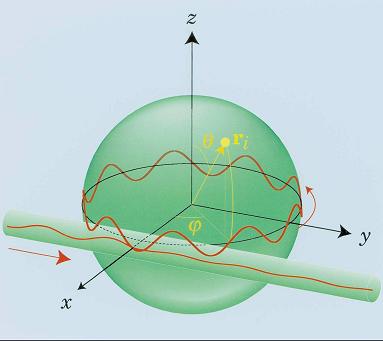Optical
biosensors capable of detecting unlabelled molecules have become
valuable tools
in life sciences as well as in drug discovery over the last 10 years.
Vollmer
et al., (2002) provided proof-of-principle for a biosensor, claimed to
have
unprecedented sensitivity for molecular detection that exploited shifts
in
optical resonances in a single transparent dielectric microparticle
(specifically
a 300 mm diameter spherical glass bead) to detect adsorption of bovine
serum albumin protein deposition. The potential of the system for
immunosensor
type applications was demonstrated by detection of streptavidin binding
to the
biotin-coated surface of a microsphere. The group went on to show
theoretically
that microspheres as small as 7.2 mm
diameter could be effectively exploited for
protein detection and that the system was particularly sensitive to
protein
adsorbing at particular locations on the microsphere surface (Arnold et
al.,
2003). The theoretical understanding of the sensitivity of the
whispering-mode
system is also progressing (Teraoka et al., 2003). Double microsphere
systems
were shown to allow for multiplexed DNA quantification (Vollmer, Arnold
et al,
2003) Also micro-disc resonators using the same detection principle
were
predicted to be sensitive (Boyd et al., 2001) , and polystyrene
micro-ring
resonators were shown to have a high sensitivity as chemical (glucose)
adsorption sensors (Chao et al., 2003).
The
sensitivity
of adsorption bioassays can be improved by ultrasonic surface wave
excitation
(Wang et al., 1999). The effect is attributed to streaming induced at
the
transducer fluid interface. The streaming patterns at a sensing surface
in a
quarter wavelength bulk acoustic wave
resonator have recently been characterised by particle image
velocimetry
techniques. Induction of small Rayleigh type vortices was observed at
many
points (Kuznetsova and Coakley, 2004). Three-fold enhancement of the
immuno-capture of 200nm fluorescent latex particles (a size so small
that
acoustic streaming rather than radiation pressure would be solely
responsible
for increased adsorption) provides
promising data (Kuznetsova et al., in preparation) on how molecular
adsorption
might also be enhanced by streaming.
Aims
- Detect and characterise whispering
modes from individual antibody-coated dielectric
microspheres.
- Measure the
change in resonance
frequency of the mode as antigen is adsorbed to the dielectric
microspheres.
- Devise a system
for holding and
sensing an array of dielectric microspheres for parallel optical
interrogation
of many antigens.
- Devise a system
to incorporate
acoustic streaming currents in the assay chamber to improve the
detection speed
and sensitivity.
|
 From
Arnold et al. Optics
Letters 28,272 (2003), Fig.1: From
Arnold et al. Optics
Letters 28,272 (2003), Fig.1:
Nanoscopic protein molecule at position ri on the surface of a
sphere near an eroded optical fiber core. The sphere and fiber
are surrounded by an aqueous solution.
|